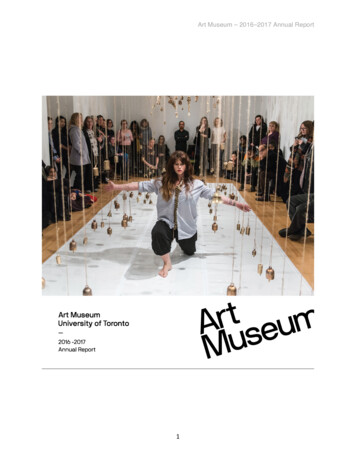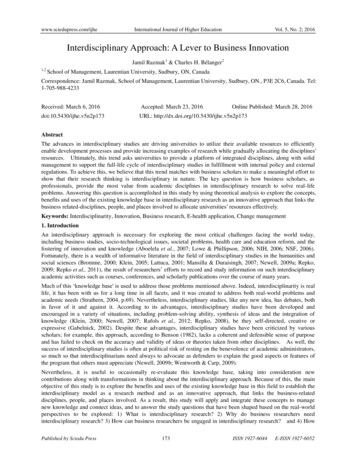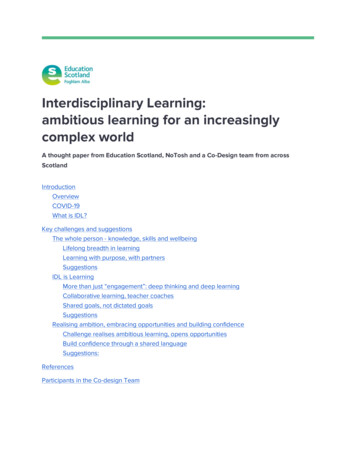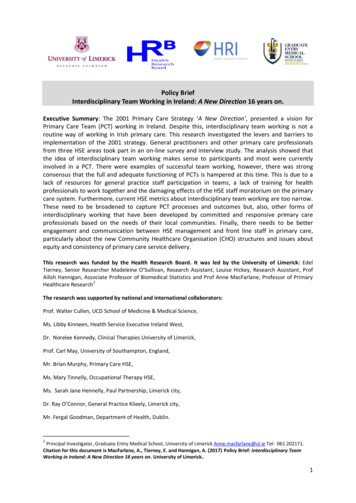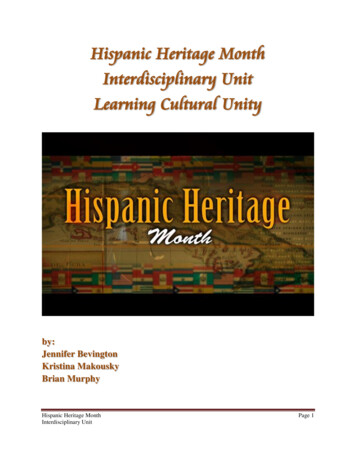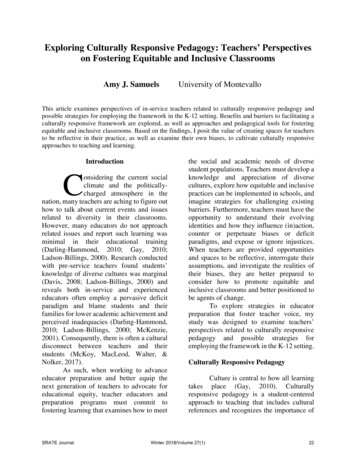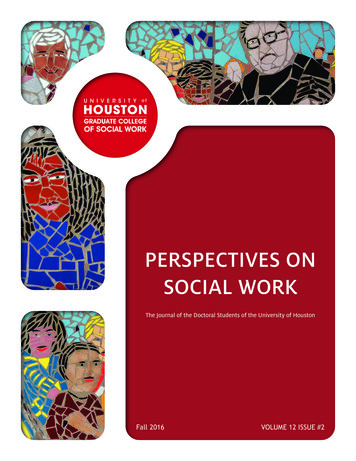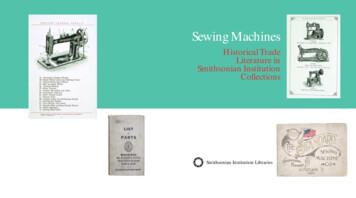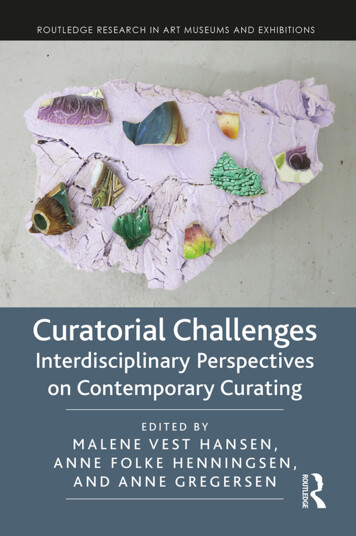
Transcription
iCuratorial ChallengesCuratorial Challenges investigates the challenges faced by curators in contemporary society and explores which practices, ways of thinking, and typesof knowledge production curating exhibitions could challenge. Bringingtogether international curators and researchers from the fields of art andcultural history, the book provides new research and perspectives on thecuratorial process and aims to bridge the traditional gap between theoreticaland academic museum studies and museum practices.The book focuses on exhibitions as a primary site of cultural exchange andargues that, as highly visible showcases, producers of knowledge, and historically embedded events, exhibitions establish and organize meanings of artand cultural heritage. Temporary exhibitions continue to increase in culturalsignificance and yet the traditional role of the museum as a Bildung institution has changed. As exhibitions gain in significance, so too do curatorialstrategies. Arguing that new research is needed to help understand thesechanges, the book presents original research that explores how curatorialstrategies inform both art and cultural history museums in contemporarysociety. The book also investigates what sort of critical, transformative, andperhaps even conservative, potential can be traced in exhibition cultures.Curatorial Challenges fosters innovative interdisciplinary exchange andbrings new insights to the field of curatorial studies. As such, it shouldbe of great interest to academics, researchers, and postgraduate studentsengaged in the study of curatorial practice, museum studies, the making ofexhibitions, museum communication, and art history.Malene Vest Hansen is Associate Professor of Art History at the Universityof Copenhagen.Anne Folke Henningsen is Associate Professor of Ethnology at the Universityof Copenhagen.Anne Gregersen is Curator at the J.F. Willumsens Museum and a PostdoctoralFellow at the University of Copenhagen.
iiRoutledge Research in Art Museums and ExhibitionsRoutledge Research in Art Museums and Exhibitions is a new series focusingon museums, collecting, and exhibitions from an art historical perspective.Proposals for monographs and edited collections on this topic are welcomed.1.Absence and Difficult Knowledge in Contemporary Art MuseumsMargaret Tali2.Art Museums of Latin AmericaStructuring RepresentationEdited by Michele Greet and Gina McDaniel Tarver3.The Twentieth Century German Art ExhibitionAnswering Degenerate Art in 1930s LondonLucy Wasensteiner4.Curatorial ChallengesInterdisciplinary Perspectives on Contemporary CuratingEdited by Malene Vest Hansen, Anne Folke Henningsen, andAnne Gregersenwww.routledge.com/ Routledge- Research- in- Art- Museums- and- Exhibitions/ book- series/ RRAM
iiiCuratorial ChallengesInterdisciplinary Perspectives onContemporary CuratingEdited by Malene Vest Hansen,Anne Folke Henningsen, andAnne Gregersen
ivFirst published 2019by Routledge2 Park Square, Milton Park, Abingdon, Oxon OX14 4RNand by Routledge52 Vanderbilt Avenue, New York, NY 10017Routledge is an imprint of the Taylor & Francis Group, an informa business 2019 selection and editorial matter, Malene Vest Hansen, Anne Folke Henningsen,and Anne Gregersen; individual chapters, the contributorsThe right of Malene Vest Hansen, Anne Folke Henningsen, and Anne Gregersento be identified as the authors of the editorial material, and of the authors for theirindividual chapters, has been asserted in accordance with sections 77 and 78 of theCopyright, Designs and Patents Act 1988.All rights reserved. No part of this book may be reprinted or reproduced or utilisedin any form or by any electronic, mechanical, or other means, now known orhereafter invented, including photocopying and recording, or in any informationstorage or retrieval system, without permission in writing from the publishers.Trademark notice: Product or corporate names may be trademarks or registered trademarks,and are used only for identification and explanation without intent to infringe.British Library Cataloguing- in- Publication DataA catalogue record for this book is available from the British LibraryLibrary of Congress Cataloging- in- Publication DataA catalog record has been requested for this bookISBN: 978- 0- 8153- 7006- 2 (hbk)ISBN: 978- 1- 351- 17450- 3 (ebk)Typeset in Sabonby Newgen Publishing UK
vContentsList of figuresList of contributorsIntroduction: Thinking and doing exhibitionsviiixv1M A L E N E V E S T H AN SE N , AN N E FO L KE H E N N INGSEN, ANDA N N E G R E G E RSE NPART ICurating within the changing role of museums as Bildunginstitutions1 Curatorship as Bildungsroman: or, from Hamlet toHjelmslev711D O N A L D P R E Z IO SI2 Curating the nude in Istanbul: some curatorial challenges 22A H U A N TM E N3 Curating the dead body between medicine and culture35K A R I N TY B J E R G4 Fashion curation: unpacking a new discipline and practice 51M A R I E R I E G E LS ME L CH IO R5 Exhibition addresses: the production of publics inexhibitions on colonial history65M ATH I A S DA N B O LT6 Multi-sited curating as a critical mode of knowledgeproductionSA B I N E DA H L N IE L SE N79
viviContentsPART IIExhibitions and/ as research7 Curating and research: an uneasy alliance9397S I M O N S H EIKH8 Exhibitions as research, curator as distraction108P E TE R B J E R RE GA A RD9 Curating a mild apocalypse: researching Anthropoceneecologies through analytical figures120N ATH A L I A B RICH E T A N D FRIDA H ASTRUP10 Curating experimental entanglements133A DA M B E N CA RD, L O UISE WH ITE L E Y, A N D CAROLINE HEJE T HON11 The forgotten and the forgettable: the making ofThe World Goes Pop and other stories147F L AV I A F R I GE RI12 Looters, smugglers, and collectors: rethinking models ofownership research and how to mediate it through theform of the exhibition158TO N E H A N SE NPART IIIRevisiting the past and challenging canons17313 Multiple modernisms: curating the postwar era forthe present177K R I S TI A N HA N DB E RG14 Contested paradise: exhibiting images from the formerDanish West Indies192M E TTE K I A KRAB B E ME YE R15 Against the grain of neutralization: exhibiting thedocumentary as a curatorial production of subjectiveknowledgeS U SA N N E N E UB AUE R211
viiContents vii16 Innovative, polemical, dogmatic: the case of Sovietexperimental museum displays, 1930– 1933223M A S H A C H L E NOVAConcluding remarks237M A L E N E V E S T H AN SE N , AN N E FO L KE H E N N INGSEN, ANDA N N E G R E G E RSE NIndex238
viiiFigures2.12.22.32.43.13.23.3The contemporary video work Reclining Woman(After Halil Paşa) (2012) by Turkish artist Özlem Şimşekat the entrance to the Bare, Naked, Nude exhibition, ahistorical survey of modern Turkish nude painting. PhotoCredit: Uğur Ataç and Engin Şengenç. Courtesy of thePera MuseumThe wall of drawings in the Bare, Naked, Nude exhibitionat the Pera Museum in Istanbul in 2015, showing nudestudies by Turkish artists educated in Europe. PhotoCredit: Uğur Ataç and Engin Şengenç. Courtesy of the PeraMuseumAn enlarged photograph of leading members of the IstanbulAcademy of Fine Arts in the early 1940s during a sessionof drawing from the live nude model. The photographeris unknown. Photo Credit: Uğur Ataç and Engin Şengenç.Courtesy of the Pera MuseumExhibition view of Bare, Naked, Nude exhibition at thePera Museum in Istanbul in 2015, showing work byTurkish artists Halil Dikmen, Hasan Vecih Bereketoğlu andHamit Görele (from left to right). Photo Credit: Uğur Ataçand Engin Şengenç. Courtesy of the Pera MuseumSpecimens of human material hover between persons andobjects of medical study. Here a specimen of an infant inthe womb and a failed treatment for the placenta blockingthe cervix. Photo Morten Skovgaard and Medical MuseionCut- out from a PKU blood sample taken from a newbornfrom which a whole genome analysis can be generated.Even small samples of tissue connect to the person. PhotoMorten Skovgaard and Medical MuseionNonmedical curation placing a hand and a foot incontinuation of a sliced arm and leg to show that the wayof cutting determines what can be known. Photo JacobKjærgård and Medical Museion26282931354243
ixList of figures ix3.4 Skeleton labeled “a negro.” This was noted in the exhibitioncaption, but not made into a theme in the exhibition. PhotoMorten Skovgaard and Medical Museion3.5 The conjoined twins rest on a soft- looking cushion, but arealso displayed dissected in three separate specimens of skin,bones, and organs. Photo Morten Skovgaard and MedicalMuseion4.1 Fashion and sustainability on display. The garmentsrepresent different sustainable approaches to fashion. Thered dresses to the left are from the Issey Miyake A- POC- collection striving for zero- waste in production. PhotoMattias Lindbäck4.2 Main exhibitions text introducing the displayed themeof fashion and sustainability. The text demonstrates thetwo narratives through the exhibition. Most unconventionalis the exhibition design text demonstrating the reflectivecuratorial practice of the display. Photo Marie RiegelsMelchior4.3 In a wonderland space is placed a gold paintedmannequin dressed in a red gown with the heart part of thebody visible and with red electric lights radiating in syncwith loud heart beats. The theme is love. The display createsan emotional experience and makes the actual dress ondisplay less distinct from the display props. Photo MattiasLindbäck4.4 Craft and color are essential components of fashion. Inthis display it is demonstrated by dresses by AlexandraMcQueen (far left and right) and Kenzo (in the middle), aswell as by the clear visual language of the exhibition designcommissioned by the artist Orlando Campbell. PhotoMattias Lindbäck4.5 Subversive practices challenges fashion design and beautyideals. For contemporary fashion exhibitions these designspush curatorial practices in new directions as the exhibitionUtopian Bodies. Fashion Looks Forward shows. PhotoMattias Lindbäck5.1 London, Sugar and Slavery. Photo and copyright: Museumof London, Docklands5.2 Montage of film stills from the video “This is Your History”in London, Sugar and Slavery. Copyright Museum ofLondon, Docklands5.3 Installation shot of the video projection in London, Sugarand Slavery. Photo and copyright: Museum of London,Docklands45465354565961687071
xx List of .4Installation shot of Tea Time: The First Globalization.Photo and copyright: Thijs Wolzak, M/ S Maritime Museumof DenmarkThe digital trade ledger in Tea Time: The FirstGlobalization. Photo: Mathias DanboltRefugees and volunteers at Copenhagen Central Station,September 2015. Photo Mathias Løvgren NielsenRefugee camp in Næstved, Denmark, December 2015.Photo: Mathias Løvgreen NielsenRooyeem Afefi who at the time the picture was taken hadbeen living in the refugee camp in Næstved for 4 monthsand 12 days. May 2016. Photo: Ulrik HasemannIntervention in public space: Trailer as foundationand substructure of a three- dimensional path- networkinstallation equipped with loudspeakers in front ofTallinn’s ferry terminal. Photo: Hieslmair, Zinganel,Stop and Go, 2015Rimini Protokoll, Remote Mitte, 2013. Photo: Ute LangkafelThe symposium. Workshop participants gathered arounda table laid with objects from the hidden parts of themuseum. Museum of Cultural History, University of Oslo/ Lill- Ann Chepstouw- LustyThe egg race. Using marshmallows and spaghetti to avoidthe collapse. Photo: Museum of Cultural History, Universityof Oslo/ Toril C. Skaaraas HofsethThe board game workshop. The board shows the overallorganization of the space into three overarching zones.Museum of Cultural History, University of Oslo/ KirstenJensen HelgelandThe exhibition. Norwegian Stone Age settlement inCOLLAPSE – Human Being in an Unpredictable World.Museum of Cultural History, University of Oslo/ KirstenJensen HelgelandTaxidermied deer in a field of bags with high- techmodified starch from potatoes grown in the area. From theexhibition. Photo: Iga KuriataView of the brown coal beds taken from Mount Søby, ahuge pile of waste dumped in what was considered analready devastated landscape, 2014. Photo: Nathalia BrichetMoesgaard Museum, Mild Apocalypse. Feral Landscapes inDenmark. Panoramic view of the exhibition. Photo: Iga KuriataWriting desk covered in graph paper and drawers withvarious objects from the field site. From the exhibition.Photo: Iga Kuriata73748185868889110114114116121123125126
xiList of figures xi9.5 The making of analytical figures. A taxidermy trophyis being coated in brown coal flakes in order to show amultilayered landscape, coinhabited by multiple species.Photo: Nathalia Brichet10.1 Exhibition photo from Mind the Gut, featuring an outsideview of the installation Landscape Epithelia (2017) by NajaRyde Ankarfeldt in collaboration with the curatorial team.Copyright: Morten Skovgaard10.2 Exhibition photo from Mind the Gut, featuringseveral Winogradsky columns and a table with objectsand stories from artists, patients, and scientists who havemanipulated their own microbiomes. Copyright: MortenSkovgaard10.3 Group photo of the curatorial team behind Mind theGut, taken at a MRI scanning session at Danish ResearchCenter for Magnetic Resonance at Hvidovre Hospital.Copyright: Louise Whiteley12.1 Dag Erik Elgin, Halbfigur einer rotblonden Frau die ineinem Sessel (sitz) vor einem Kamin auf dem zwei Vasenmit Blumen stehen über dem ein von Matisse gemaltes Bildhängt (2015) (Half- Figure of a Red- Blonde Woman Sittingin an Armchair in Front of a Fireplace, On Which TwoVases With Flowers Are Standing, Above Which a Paintingby Matisse Is Hanging), eleven canvases, each the same sizeas Matisse’s Profil bleu devant la cheminée (2015)12.2 Michael Rakowitz: Enemy Kitchen (2003– ongoing)12.3 Late Sabbath lunch served at The Fritt Ord Foundationtogether with chef Tore Namstad12.4 Marianne Heier, The Guest (2015). Meteorite, posters,sound installation, and performance12.5 Celine Condorelli, Average Spatial Compositions (2015),milk steel, plywood, upholstery, paint, dimensions13.1 Postwar: Art Between the Pacific and the Atlantic,1945– 1965. Exhibition poster, Haus der Kunst, 201613.2 Mark Tansey: Triumph of the New York School, 1984,Oil on canvas, 188 x 304.8 cm, Whitney Museum ofAmerican Art, New York13.3 From the section 1. Aftermath: Zero Hour and the AtomicEra at Postwar: Art Between the Pacific and the Atlantic,1945– 1965. Installation view, Haus der Kunst, 2016.Photo: Maximilian Geuter13.4 Postwar: Art Between the Pacific and the Atlantic,1945– 1965, Installation view, Haus der Kunst, 2016.Photo: Maximilian Geuter127134137140163165166167168178179184185
xiixii List of figures13.5 Postwar advertised at Haus der Kunst, Munich 2016.Photo: Kristian Handberg14.1 Sébastien Le Clerc. “Sucrerie,” Engraving. Illustrationfor Jean- Baptiste du Tertre: Histoire générale des Antilleshabitées par les François, 166714.2 Unknown artist. “De Insulis nuper in mari Indico repertis,”Woodcut. Illustration for Columbus’s letter “Epistolade insulis nuper in mari Indico repertis,” reproducedin Carolus Verardi. Cæsenatis Cubicularii Pontificii inhistoriam Bætecam ad R. P. Raphaelem Riarium S. GerogiiDiaconum Cardinalem, 149414.3 Frederik von Scholten. Frederikssted, 1837. Coloreddrawing. Helsinore, M/ S Maritime Museum of Denmark14.4 Unknown artist. Portrait of Louisa Bauditz and HerWet Nurse, Charlotte Hodge, ca. 1847. Daguerreotype.Copenhagen, The National Museum of Photography14.5 Art historian Temi Odumosu speaking to writer andsatirist Anna Neye about the computer game PlayingHistory: Slave Trade on film in the exhibition Blind Spots:Images of the Danish West Indies Colony. May 19, 2017– February 3, 2018. Copenhagen, The Royal Danish Library(photographer: Laura Stamer)14.6 What Lies Unspoken. Participatory sound interventiondeveloped by art historian Temi Odumosu from the LivingArchives Research Project, Malmö University, Sweden,in collaboration with the Royal Danish Library and theNational Gallery of Denmark. Installation photo from theexhibition Blind Spots: Images of the Danish West IndiesColony. May 19, 2017– February 3, 2018. Copenhagen, TheRoyal Danish Library (photographer: Brian Berg)14.7 Jeannette Ehlers. Whip it Good, 2014. Video installation.Courtesy of the artist. La Vaughn Belle. Chaney (we livein the fragments 003), 2016. Digital Print. Courtesy ofthe artist. Installation photo from the exhibition BlindSpots: Images of the Danish West Indies Colony. May 19,2017– February 3, 2018. Copenhagen, The Royal DanishLibrary (photographer: Laura Stamer)14.8 Nanna Debois Buhl. The Mapmaker, 2008. Installationwith two rugs and a video. The rugs were produced inco-operation with Ege Tæpper for the Socle du MondeBiennial at HEART Herning Museum of ContemporaryArt. Courtesy of the artist. Installation photo from theexhibition Blind Spots: Images of the Danish West IndiesColony. May 19, 2017– February 3, 2018. Copenhagen, TheRoyal Danish Library (photographer: Laura Stamer)187194197198200201202203204
xiiList of figures xiii14.9 Various photographers. Postcards from St. Croix,St. Thomas, and St. John. Various techniques, 1897– 1993.La Vaughn Belle. Photomontage Series, 2016. Photographs,digital print. Courtesy of the artist. Nanna Debois Buhl.Looking for Donkeys, 2009; video installation on twoscreens. 16 mm film, HD transfer (audio in collaborationwith Jonny Farrow and Pejk Malinovski. Voiceover: NajaMarie Aidt). Installation photo from the exhibition BlindSpots: Images of the Danish West Indies Colony. May 19,2017– February 3, 2018. Copenhagen, The Royal DanishLibrary (photographer: Laura Stamer)14.10 La Vaughn Belle. Photomontage Series (“St. Croix Pickney”),2016. Photographs, digital print. Courtesy of the artist15.1 Dokumentation Rainer Ruthenbeck, installation image,Villa Romana, Florence, 2011. Villa Romana, Florence,photo: Ela Bialkowsks, OKNOstudio15.2 Dokumentation Rainer Ruthenbeck, installation image,Villa Romana, Florence, 2011. Villa Romana, Florence,photo: Ela Bialkowska, OKNOstudio16.1 Experimental Composite Display, Art of the Capitalist Era,State Tretyakov Gallery, Moscow, November 1931– February1932. Curator: Aleksei Fedorov- Davydov. Front- facingwall text reads: “Earlier rationalism and realism in art arereplaced by religious symbolism and sensuality.” Left wall textreads: “Bourgeoisie, fighting against the workers’ movement,forms an alliance with the serf- owning gentry.” PhotographicArchive of the State Tretyakov Gallery, Moscow16.2 Experimental Composite Display, Art of the CapitalistEra, State Tretyakov Gallery, Moscow, November1931– February 1932. Curator: Aleksei Fedorov- Davydov.Wall text reads: “Bourgeois art in the blind alley offormalism and self- negation.” Photographic Archive of theState Tretyakov Gallery, Moscow16.3 Composite Marxist Display, The Art of the Great IndustrialBourgeoisie on the Eve of the Proletarian Revolution, StateTretyakov Gallery, Moscow, November 1932– February1933. Curator: Aleksei Fedorov- Davydov. Wall textreads: “Bourgeois formalism and objectivism- cubism mutatesinto a self- serving game of formal- aesthetic artistic means.”Photographic Archive of the State Tretyakov Gallery, Moscow16.4 Introductory Gallery, Concise Experimental Exhibitionof the Art from the Era of Imperialism, State RussianMuseum, Leningrad, June 15, 1931– early 1932.Curators: Nikolai Punin, Vera Anikieva, and others. Walltext above the doorway reads: “As a Worldview Anarchism205206212219226227229
xivxiv List of figuresis Bourgeois Ideology Turned Inside Out.” (Lenin,underlining in original). Photographic Archive of the StateRussian Museum, St. Petersburg16.5 Gallery of Suprematism, Concise Experimental Exhibitionof the Art from the Era of Imperialism, State RussianMuseum, Leningrad, June 1931– early 1932. PhotographicArchive of the State Russian Museum, St. Petersburg230232
xvContributorsAuthorsAhu Antmen, PhD, is Associate Professor and lecturer of modern and contemporary art at Marmara University Faculty of Fine Arts in Istanbul,Turkey. Her recent publications include a compilation of her essays,Bodies with Identities – Art, Identity, Gender (2014) and Bare, Naked,Nude – A Story of Modernity in Turkish Painting (2015).Adam Bencard, PhD, is Associate Professor at Medical Museion and theNovo Nordisk Foundation Center for Basic Metabolic Research,University of Copenhagen. He was one of the lead curators of the Mindthe Gut project, which built in part on his cultural and philosophicalresearch into the microbiome. Bencard’s research focus revolves aroundmaterialism and materiality, explored in dialogue with experimentalcuration practice.Peter Bjerregaard, PhD, is Senior Adviser of Exhibitions at Museum ofCultural History, University of Oslo. His research is mainly concernedwith a theoretical rethinking of the museum institution and withthe potential of exhibitions as research. Bjerregaard is coeditor ofMaterialities of Passing (Routledge, 2016) and editor of Exhibitions asResearch (Routledge, 2019).Nathalia Brichet, PhD, is a postdoctoral researcher in anthropology atAarhus University. Her research is focused on extractive industries inGreenland and Denmark where she uses fieldwork to collect and exhibitanthropological analyses. She has cocurated exhibitions at the NationalMuseum of Denmark, National Museum of Ghana, and MoesgaardMuseum in Denmark. With fellow contributor Frida Hastrup she haspublished “Sensationelle trivialiteter – Museer i vores eksotiske verden”and “Terrestrials in Ruined Landscapes: Potentials in an AnthropoceneEra” (Fabrikkens Forlag, 2015).Masha Chlenova, PhD, is a modernist art historian and curator, specializingin the Russian avant- garde. She currently works as project- based curator
xvixvi Contributorsat Stedelijk Museum Amsterdam and teaches art history at New SchoolUniversity in New York. She recently curated Russian Revolution: AContested Legacy at the International Print Center New York and co- organized Inventing Abstraction, 1910– 1925 at The Museum of ModernArt in New York. She has published widely on modern art and theRussian avant- garde.Mathias Danbolt, PhD, is Associate Professor in Art History at the Universityof Copenhagen. He specializes in contemporary art and performance witha focus on queer, feminist, antiracist, and decolonial perspectives on artand culture. He is currently researching the effects and affects of Danishand Nordic colonialism in the field of art and visual culture. Danbolt wascocurator of the exhibition Blind Spots: Images of the Danish West IndiesColony (2017– 2018) with Mette Kia Krabbe Meyer and Sarah Giersingat the Royal Danish Library. Recent publications include articles in booksincluding Racialization, Racism and Anti- Racism in the Nordic Countries(Palgrave, 2018), Otherwise: Imagining Queer Feminist Art Histories(Manchester University, 2016), and Not Now! Now! Chronopolitics, Artand Research (Sternberg, 2014).Flavia Frigeri, PhD, is an art historian and curator, and current TeachingFellow in the History of Art department at University College London.Previously she served as a curator at International Art (2014– 2016) andassistant curator at Tate Modern (2011– 2014), where she worked onexhibitions, acquisitions and permanent collection displays. She cocurated(with Jessica Morgan) The World Goes Pop. Previous projects includeHenri Matisse: The Cut- Outs, Paul Klee: Making Visible, and Ruinsin Reverse. From 2010 to 2011 she was the Solomon R. GuggenheimFoundation Hilla Rebay International Fellow. She has written widely onpostwar Italian art, pop and contemporary art, and exhibition histories.Kristian Handberg, PhD, is a postdoctoral researcher with the project“Multiple Modernities: World Images and Dreamworlds in Art andCulture, 1946– 1972” at Louisiana Museum of Modern Art and Universityof Copenhagen (2015– 2018). His dissertation for the University ofCopenhagen was titled There’s No Time like the Past: Retro betweenMemory and Materiality in Contemporary Culture (2014). Recentpublications include “The Shock of the Contemporary: documenta IIand Louisiana Museum,” OnCurating 33 (2017) and “The World GoesModern: New Globalized Framings of the Postwar Era in the ExhibitionsAfter Year Zero and The World Goes Pop,” Journal of Aesthetics andCulture 8 (April 2016).Tone Hansen has been Director of the Henie Onstad Kunstsenter, Norway,since 2011. She served as Head of Council for Arts Council Norway,2016– 2020 and has curated numerous exhibitions, such as In Search of
xviContributors xviiMatisse. She is a former curator at HOK and scholar at the Academy ofFine Art, Oslo, with the project Megamonstermuseum. She has edited thereaders Looters, Smugglers and Collectors: Provenance Research and theMarket (Walther König, 2015); Phantom of Liberty: Contemporary Artand the Pedagogical Paradox (Sternberg Press, 2014); We Are Living on aStar (Sternberg Press, 2014), and (Re)Staging the Art Museum (Revolver,2011), as well as of catalogues such as Marina Abramovic: Drawings1963– 2017 (Walther König, 2017) and Catherine Opie: Keeping an Eyeon the World (Walther König, 2017).Frida Hastrup, PhD, is Associate Professor in Ethnology, the Saxo Institute,University of Copenhagen. She is the leader of the research projectNatural Goods? Processing Raw Materials in Global Times (fundedby the Independent Research Fund Denmark’s Sapere Aude program),which includes exhibitions as part of its output. This project hasresulted in cocurated exhibitions at the National Museum of Denmarkand at Moesgaard Museum. With Nathalia Brichet she has published“Sensationelle trivialiteter – Museer i vores eksotiske verden” and“Terrestrials in Ruined Landscapes: Potentials in an Anthropocene Era.”Marie Riegels Melchior, PhD, is Associate Professor in European Ethnologyat the University of Copenhagen. In her research and teaching shefocuses on the cultural history of fashion, twentieth- century Danishfashion, museum studies, and fashion in museums in particular. Herrecent publications include Fashion and Museums: Theory and Practice(coedited with Birgitta Svensson, Bloomsbury, 2014) and Dansk påmode! Fortællinger om design, identitet og historie i og omkring danskmodeindustri (Museum Tusculanums Forlag, 2013).Mette Kia Krabbe Meyer, PhD, is Senior Researcher in the NationalCollections at the Royal Danish Library in Copenhagen where sheconducts research on photography and other types of images, andconducts curatorial work. Recent publications include “In the Eye of theStorm: Photographs of Russian Prisoners of War in Denmark during theFirst World War,” Photography and Culture (September 2017): 1– 30, and(with N. I. Boserup) “The Illustrated Contract between Guaman Pomaand the Friends of Blas Valera: A Key Miccinelli Manuscript Discoveredin 1998” in Unlocking the Doors to the Worlds of Guaman Poma andHis Nueva coroníca (Danish Humanist Texts, 2015).Susanne Neubauer, PhD, is a curator and art historian who gained her doctorate with a thesis on the documentation of Paul Thek’s environments.Her expertise covers installation art and questions of materiality anddocumentation, Brazilian art and postwar modernism, contemporarycurating, and human- animal relationships in the context of ecocultureand artistic practices. Her recent published work has appeared in RIHA
xvixviii ContributorsJournal; Konsthistorisk tidskrift; Theory, Culture and Society; ThirdText, and ARS (São Paulo). She is currently working on the book MissedDiversities: Brazilian Art in Post- 1945 Germany.Sabine Dahl Nielsen, PhD, is a postdoctoral researcher at KØS Museum ofArt in Public Spaces, Køge, Denmark, and at Department of Architecture,Design and Media Technology at Aalborg University. Her dissertation, Artin Urban Public Spaces: Conflicts and Negotiations as Critical PoliticalPractices (2015), defended at KØS and the University of Copenhagen, willbe published by Museum Tusculanums Forlag. As part of her doctoralstudies she participated in the research network Curatorial/ Knowledgeat Goldsmiths College under the supervision of Professor Irit Rogoff.She is author of Det fotografiske rum (Forlaget Politisk Revy) and hascontributed to anthologies, exhibition catalogues, and journals such asPeriskop, Salon 55, Nordic Museology, and Nordic Journal of CulturalPolicy.Donald Preziosi, PhD, is Emeritus Professor of Art History and CriticalTheory, UCLA, and Distinguished Research Professor. He is the author,editor, and coeditor of fourteen books on art and architectural history, theory, and criticism, and the interdependence of philosophy,theology, politics, and museology. He has held visiting professorshipsin the United States, Europe, Istanbul, and Australia. His most recentbook is Art, Religion, Amnesia: The Enchantments of Credulity(Routledge, 2014).Simon Sheikh, PhD, is a curator and theorist. He is Reader in Art andProgram Director of MFA Curating at Goldsmiths, University of London.He is a correspondent for Springerin and a columnist for e- flux. His latestpublication is Former West: Art and the Contemporary After 1989 (MITPress, 2016), coedited with Maria Hlavajova. He is currently working ona book about art and apocalypse entitled It’s After the End of the World.Caroline Heje Thon is a research assistant and cocurator of the Mind theGut project at the Novo Nordisk Foundation Center for Basic MetabolicResearch and Medical Museion, University of Copenhagen. She has amixed background within biology, art, and art history, which reflects hergeneral interest in people- environment relations and in particular how artand art- science collaborations can affect these relations.Karin Tybjerg, PhD, is Associate Professor at Medical Museion, Universityof Copenhagen, combining research and curatorship. She was headcurator of the exhibition The Body Collected and has published on anatomical collections, history of science, and museol
i Curatorial Challenges Curatorial Challenges investigates the challenges faced by curators in con- temporary society and explores which practices, ways of thinking, and types of knowledge production curating exhibitions could challenge.
